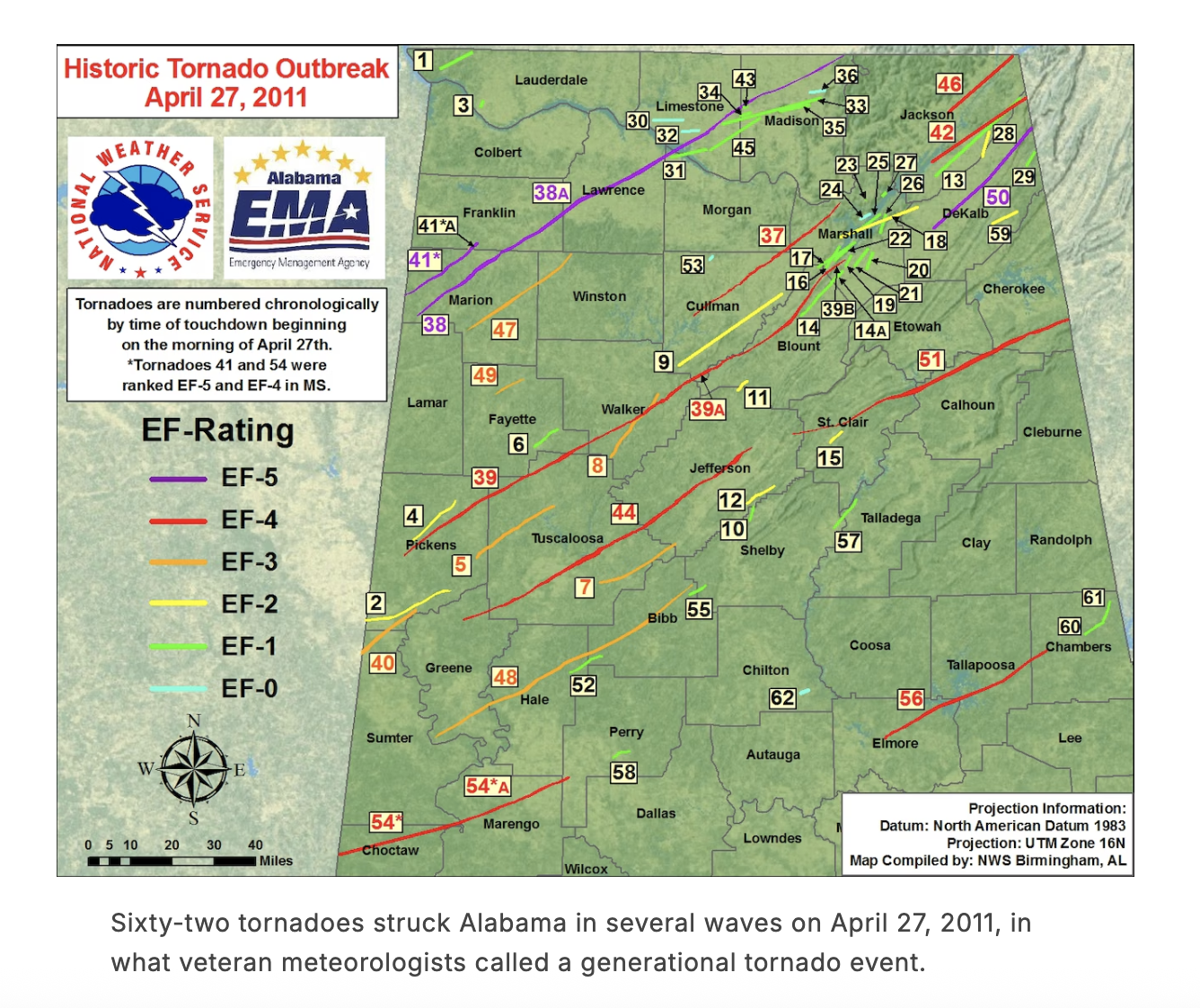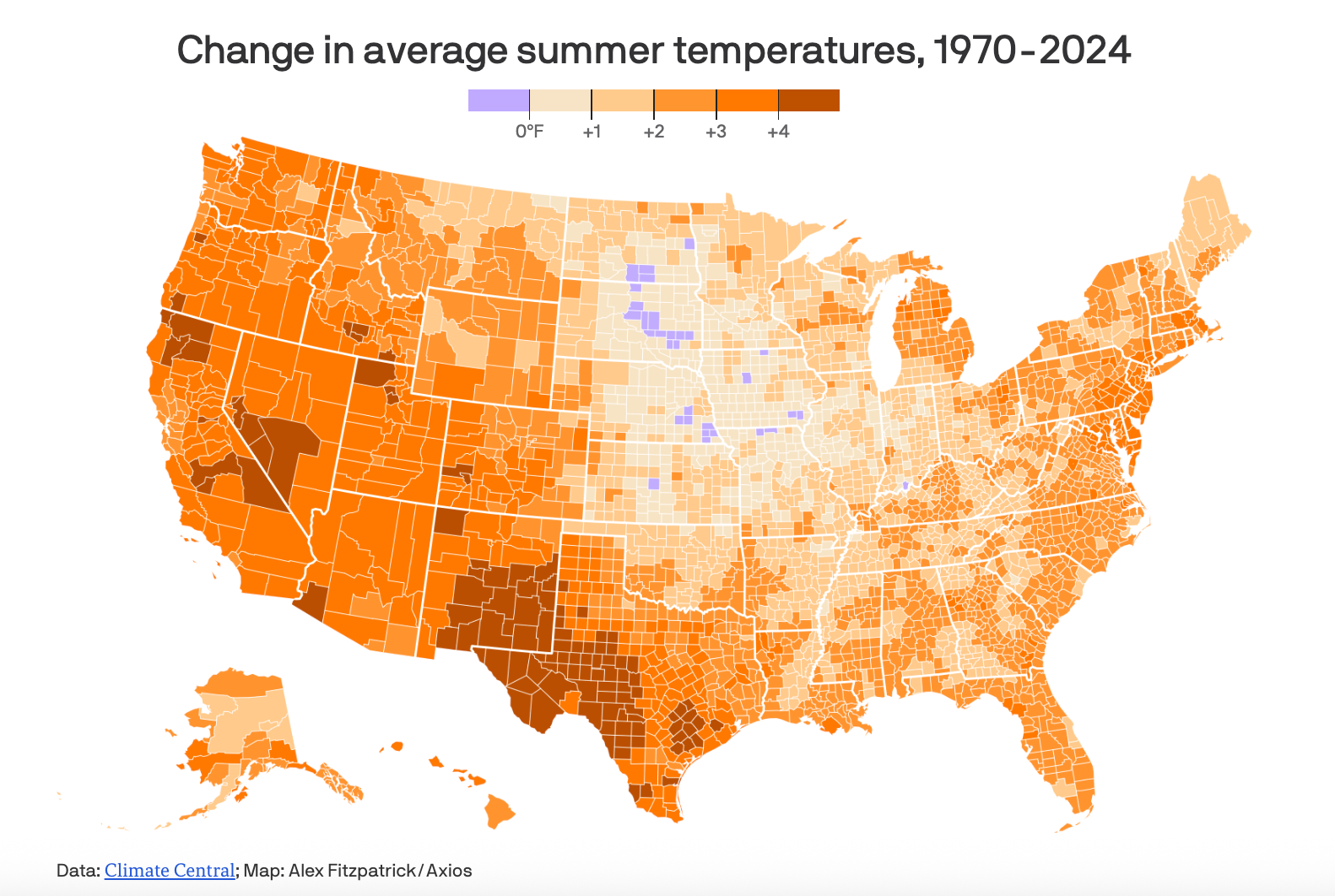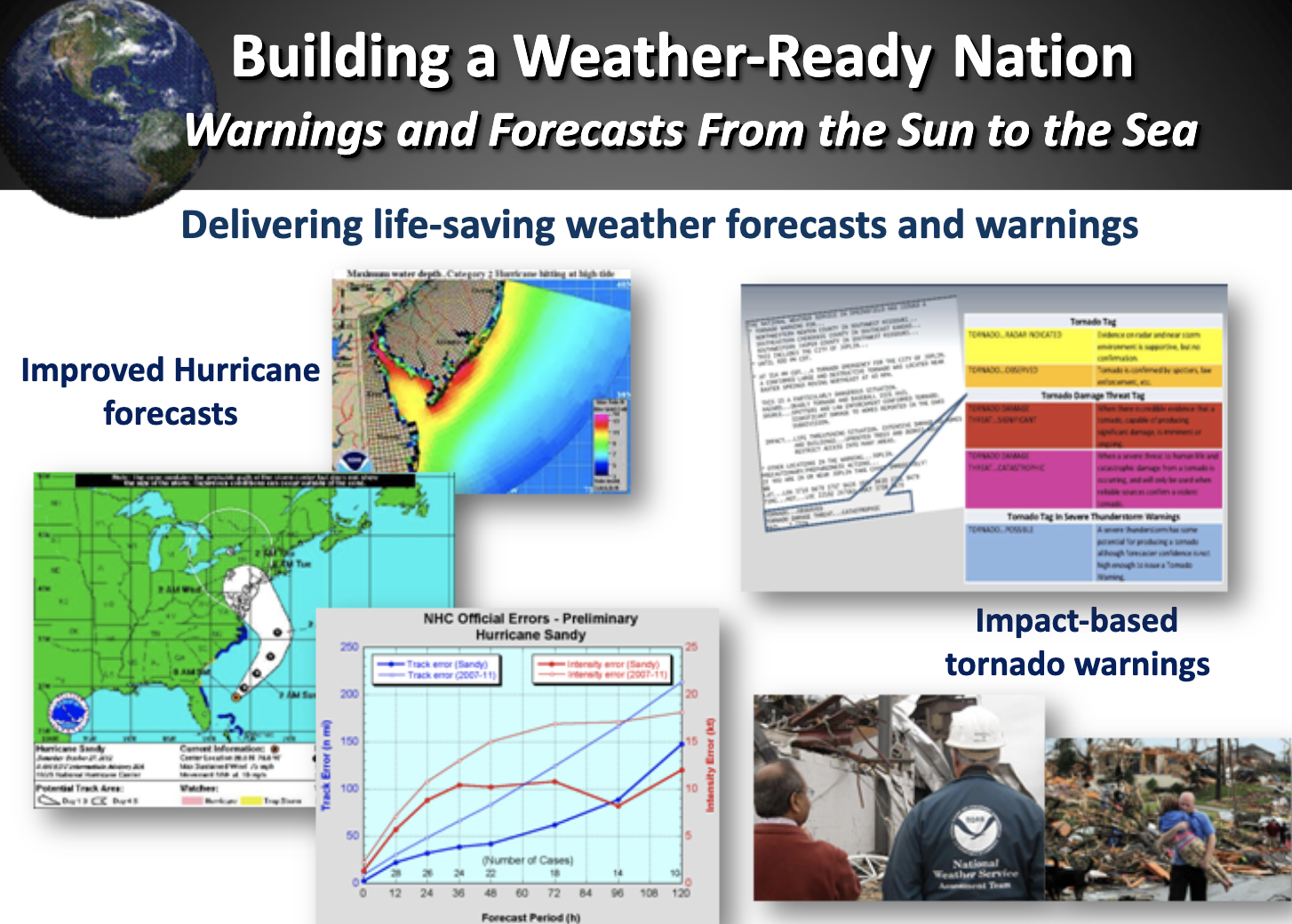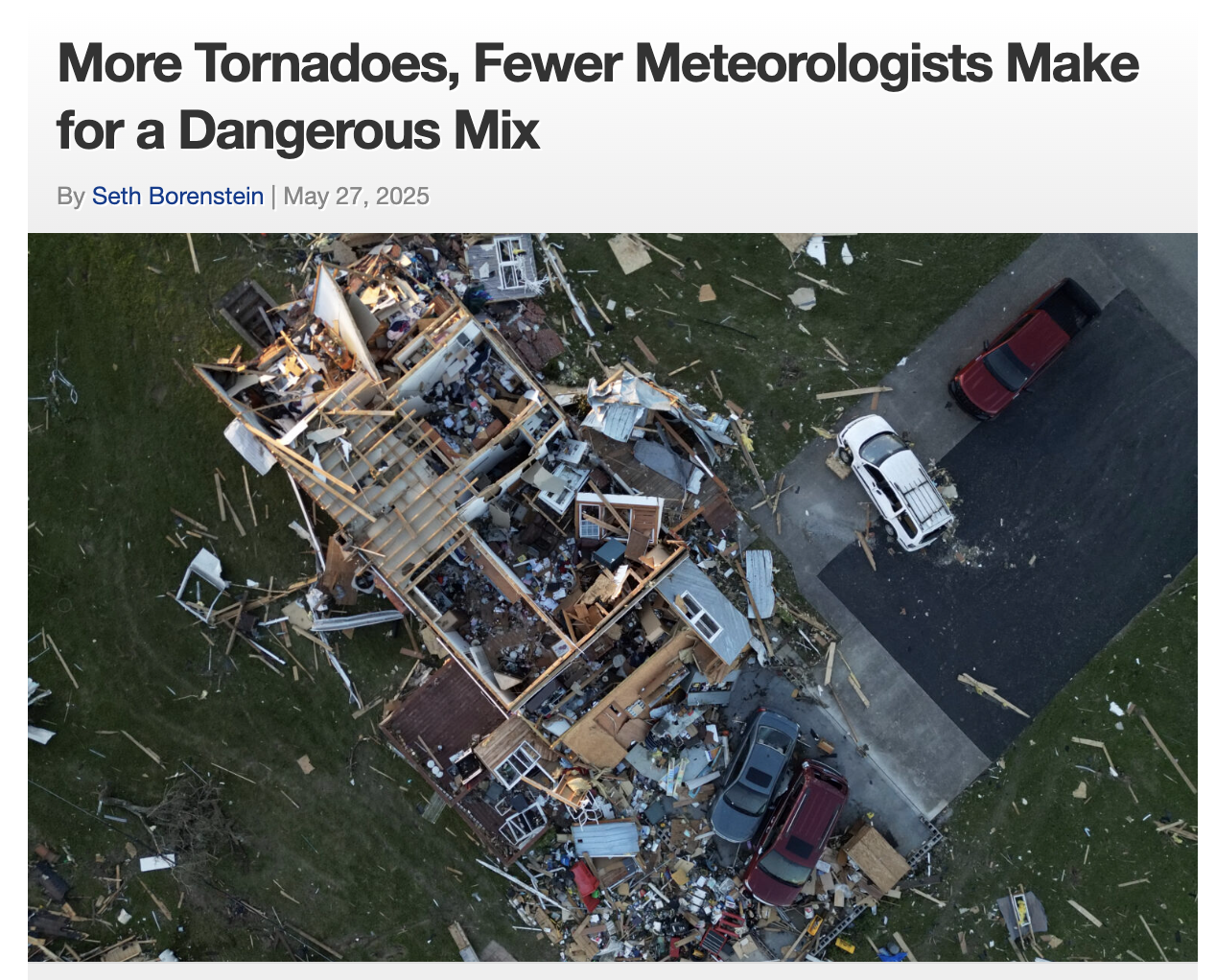
On 22 May 2011, the strongest kind of tornado currently measured — an EF-5 — devastated Joplin, Missouri, killing 158 people and injuring more than 1,000 others.
It was the deadliest single U.S. tornado since 1950.
And that was only part of the story of 2011.
Less than four weeks before the Joplin tornado, a "super-outbreak" of tornadoes wreaked havoc on the eastern half of the US, killing more than 250 people. On 27 April 2011, 62 tornadoes were confirmed in the state of Alabama alone.

All told in 2011:
There were nearly 200 separate events that caused at least $1 billion in damages, more than any year on record, according to the National Oceanic and Atmospheric Administration. It was the year Hurricane Irene brought catastrophic flooding to the Northeast, record-breaking tornadoes ripped through the Midwest, and intense drought in the South wrecked crops and led to the driest year on record for Texas.
After a year in which tornadoes alone killed 553 people in the U.S., the Obama administration took major steps to reduce fatalities and property loss in future extreme weather events.
Obama Equipped America to Withstand Extreme Weather
By 2012, the reality that rising temperatures would lead to more extreme weather events in the US was already baked into every expert's calculations.
Heat is a killer all by itself. It has long been America's "number one weather-related killer."
Not only does more heat equate to more deaths. Rising temperatures also exacerbate the impact of tornadoes, hurricanes, and wildfires, all of which continue to grow more frequent and more intense.
Wisely, Obama took a multifaceted approach to increasing America's weather resiliency — combining scientific advancements in forecasting, stronger building codes, improved public preparedness, and enhanced emergency management.

The wisdom of Obama's strategy has been reinforced — both during his time in office and since — because, as predicted, the frequency and intensity of deadly heatwaves affecting the US continue to increase.
According to Axios, 97% of 242 US cities measured show higher summer temperatures vs. 1970, with an average increase of +2.6°F. Numerous cities have averages more than 4 degrees above 1970 levels, with the biggest increases recorded in Reno, Nevada (+11.3°F), Boise, Idaho (+6.3°F), and El Paso, Texas (+6.2°F).
A separate analysis shows that heat-related deaths in the US have risen dramatically since 1999 and, having accelerated since 2016, reached 2,325 in 2023.
Under Obama, The National Weather Service Rose to the Challenge
In the aftermath of the Joplin tragedy, Obama offered the strategic vision, backed by the necessary funding, to build America's weather resilience.
By prioritizing technical innovation and empowering scientists, Obama enabled the NOAA's National Weather Service (NWS) to pursue a clear goal: To make America a "Weather-Ready Nation (WRN)."
The WRN concept built on the NWS's 150-year tradition of relentless dedication "to providing accurate, timely forecasts to citizens across the nation" with a new approach "to help increase readiness, responsiveness, and resilience for environmental hazards nationwide."

Over the next decade and more — despite the ongoing climate crisis and numerous extreme weather events — the National Weather Service did indeed succeed in creating a more prepared, resilient nation.
A critical element of the success of the WRN initiative was in “Last Mile” forecasting which emphasized "the connection between forecasts and the life-saving decisions that allow communities to withstand them."
In 2017, Donald Trump Inherited a "Weather-Ready Nation"
Less than six weeks after Trump was inaugurated in 2017, a miracle occurred:
On February 7, 2017 at least six tornadoes touched down in and around around New Orleans, LA, home to more than three million people. Two of these dangerous storms touched down near the city itself, including an EF-3 that tore through East New Orleans. Remarkably, no fatalities were reported.
This outcome, according to National Weather Service, was a "shining example of the success of the NWS’s Weather-Ready Nation initiative," the groundwork for which had been laid in the aftermath of 2011.

Even though more than 700 homes and numerous businesses and industrial buildings were damaged and destroyed, the actions of NWS staff and their partnerships within communities turned what would previously have been a mass fatality event into one in which not a single life was lost:
The staff was able to provide lead times exceeding 30 minutes for tornado warnings, giving people ample time to prepare and shelter, including schools in the tornado’s path. First responders like the Louisiana State Police were advised of specific locations where tornadoes were forecast to cross interstates. Local emergency managers were in constant contact with forecasters either directly or via other means such as NWS Chat and Twitter, providing critical situational awareness and response that one official declared a “lifesaver.”
Finally, it seemed, the National Weather Service had "fully recognized the key to accomplishing its mission" and, by recognizing "the connection between forecasts and the life-saving decisions that allow communities to withstand them" turned America into a prepared, resilient nation that, "moving forward... is prepared for anything."
In the 10 years through 2024, there were fewer than 50 tornado-related deaths in seven out of ten years. In 2024, tornado-related fatalities totaled 54, one higher than the 10-year average. But even that total was impressive. As Insurance Journal notes, 2024 was "the second-busiest tornado year on record."
Fast forward to May 2025 and one thing is clear:
Trump 2.0 Is Destroying America's Weather Service — With Deadly Results
So far this year, there have been 62 tornado-related deaths — 15% more than were recorded in all of 2024.
On 16 May 2025, at least 32 people were killed by tornadoes and storms that tore through Kentucky, Missouri and Virginia.
As USA Today reported, most of the deaths in Kentucky "were concentrated in the eastern part of the state, which is served by the weather service's Jackson, Kentucky, forecast office... one of four forecast offices that no longer has overnight staffing because of a shortage of meteorologists."

While the Jackson office in Kentucky was fully staffed the night of the storms, it was because back-up was called in to handle the "all-hands-on-deck" situation.
Sadly, there will be fewer hands to put on deck in future emergencies. Almost 600 people left the National Weather Service during the first three months of the new Trump Administration, including 100 people who were fired.
Today, for the first time in decades, not all forecast offices have "24/7" staffing and America's entire weather forecasting infrastructure is stretched thin. The number of forecast offices that will be not staffed overnight will soon double, from four to eight.
As the weather service union tells USA Today: "52 of 122 weather forecast offices have staffing shortages above 20%," a level which represents "a critical threshold," says Insurance Journal.
Among the severely short-staffed offices in tornado-prone areas are "Jackson, with a 25% vacancy rate, Louisville, Kentucky, with a 29% vacancy rate, and Wichita, Kansas, with a 32% vacancy rate."
Expect More Extreme Weather, Fewer Warnings
As May 2025 comes to a close, 174 wildfires are currently blazing in Canada, with more than 90 of those "out of control" as of May 30. A total of 1.5 million acres have already burned in Saskatchewan and Alberta this year, reports USA Today.
Smoke from the blazes is expected to fall heavily over Midwestern states, including Wisconsin, Minnesota, and Michigan, and cut across the country to reach the Carolinas by May 31, according to FireSmoke Canada.
Meanwhile, reports The Sacramento Bee, "California is on the cusp of wildfire season, which experts warn could be worse than usual."
June 1 marks the official start of the Atlantic hurricane season. Experts predict an above-average number of major hurricanes for 2025.
And, according to Dr. David Shiffman, of the Union of Concerned Scientists, "it’s absolutely true that cuts to the National Weather Service will make it harder to predict and monitor hurricanes and tornadoes, which will endanger countless lives and livelihoods." Read his full piece to learn about "Ten Vital Services Provided by NOAA (Beyond the National Weather Service)."
Trump 2.0 Will Bring More Death and More Destruction
Trump's cuts to NOAA and the National Weather Service will have a major impact on Americans for reasons they may not even realize.
As the BBC reported in March:
The data that powers Americans' smartphone weather apps and informs local meteorologists comes from NOAA and its subsidiary, the National Weather Service. Americans use it to decide what to wear, and whether to meet friends in the park or indoors. They rely on it during hurricanes, tornadoes or blizzards.
Airlines and federal aviation officials need forecasts to safely guide planes through the sky. Retailers use them to schedule customer deliveries. Shipping companies and fisheries in the Great Lakes rely on NOAA updates about ice conditions and algae blooms.
As of March 2025, NOAA was delivering 10% less data from weather balloons, which track temperature, wind speed, humidity and other atmospheric readings.
Trump's preliminary budget request released in May would cut NOAA's budget by 24%, nominally to stop wasting money on "climate change."
As Christian Scientist Monitor reports, this makes "scientists and industry experts deeply concerned that NOAA won’t be able to fulfill services to people who depend on them, such as fishers, farmers, and the general public."
Meanwhile, the office of Oceanic and Atmospheric Research ⎯ which Propublica calls "a nerve center of global climate science, data collection and modeling" ⎯ would be cut by 74%.
This lack of data will not just affect US weather forecasting, but have ripple effects around the world.
As one expert told Propublica, losing the models, and all the sensor networks and supporting NOAA research programs that feed them means that:
“We’ll go back to the technical and proficiency levels we had in the 1950s."
Another said:
“If we don’t understand what’s happening and why it’s happening, you can’t be adapting, you can’t be resilient....We’re going to see huge impacts on infrastructure and lives lost in the U.S.”
Funding the NWS costs the average American just $4 a year — "a cup of coffee" JoAnn Becker, president of the National Weather Service Employees Organization tells Scientific American.
Slashing the budget costs us a whole lot more than that.
As Propublica notes, one 2024 study by the American Meteorological Society found that NOAA’s weather forecasts alone "generate more than $73 in savings for every dollar invested in them."
Up to 19 Named Storms Are Expected this Hurricane Season
As the Houston Chronicle noted this week, the widespread budget cuts at NOAA may or may not have an immediate impact in 2025, but with impaired research and reduced weather observation, "the concern over forecast degradation is likely going to grow over time."
Trump is not just turning America away from a world-leading, science-based commitment to weather forecasting. He's also rejecting the financial and economic benefits that better forecasting delivers. Between 2007 and 2020, notes the Houston Chronicle, improved forecasts saved on average of "$5 billion for each major hurricane. "
The Trump weather crisis won't just bring more death and destruction. It's a self-inflicted wound that will cost Americans billions — or even trillions — in the years ahead.
Thanks for reading! While paid subscriptions (billed to TLD Media LLC) and one-time tips are always welcome, all content to this ad-free newsletter is free, so subscribe for $0 and you won’t miss anything. And feel free to share this content knowing there’s never a paywall!
P.S. This really is the time to get off X once and for all. Please find me on Bluesky and these other places.
Subscribe to Unprecedented
Subscribe to the newsletter and unlock access to member-only content.